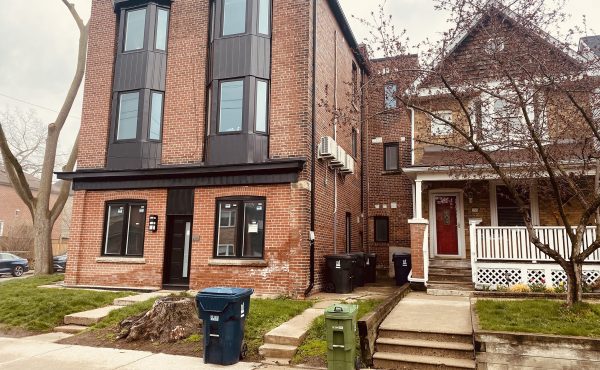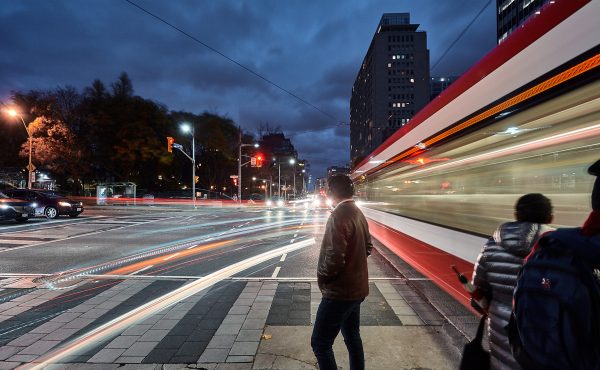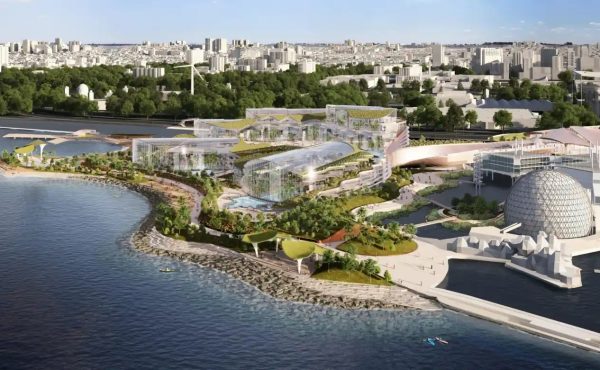
Cross-posted from No Mean City, Alex’s personal blog on architecture
Two weeks ago I took my son to Canada’s Sugar Beach. He’s a toddler, and I wasn’t sure whether he’d enjoy the visit. The newest park on the waterfront is a playful two acres of landscape design by Claude Cormier, with candy-striped hunks of granite and small, sugar-pile hills of grass – but that conceptual play is a bit over the head of an 19-month-old. But I liked it a lot, and surprisingly so did he: those rocks and hills are great to climb and tumble on, and the large artificial beach, with its wispy white sand imported from Ohio, is one serious sandbox. Throw in the sights of the lake (boat! seagull!) and you have a winning park experience for almost anybody.
The sad thing was, we had the place to ourselves. It was about eight on a Saturday morning – an hour when the only people using parks are parents, dog owners, and elders practicing tai chi – and there was almost nobody else there. The adjacent Redpath Sugar plant and the new Corus Quay office building (handsome but underwhelming) were quiet.
Sugar Beach’s time hasn’t come yet, I thought. The park is still half-enclosed in chain link fence. There are construction trailers nearby. But eventually it’s going to anchor a new district – Waterfront Toronto has just released plans for the East Bayfront neighbourhood which will end a block away, so give it a few years.
Then I went back this past weekend with my son and my wife. And this time other people had the same idea. The park was crawling with children; at least five families had trekked there with toys, picnic blankets and bathing suits. The park’s new water feature was open: a series of fountains set into a granite maple leaf, spraying unpredictable geysers of water. My son joined a crowd of kids dancing and dodging for hours. Meanwhile I got to examine the details more closely: the high pink steel umbrellas, paving with its edges crumbled like a sugar cube, the artfully scattered maple trees, the red and white candy stripes across the granite outcropping. Then we had a nice picnic and shared sand toys with the family in the next set of Muskoka chairs.
This tells me a few things. One, Torontonians are eager to get a new perspective on the lakefront. It’s not only design obsessives like me who are interested in seeing a new park in a desolate stretch of downtown. It’s a tough walk to get there, even from the nearby St. Lawrence neighbourhood, but that didn’t stop us all from showing up.
Two: good parks are kid-friendly. As any parent learns, having a child takes you out constantly into public space, especially parks, and kids can play almost anywhere, but some places work better. Cormier’s design in this case (with The Planning Partnership) provides enough variety of topography and texture to serve adults’ and kids’ sensibilities. To me it feels a bit spare for the context, but once many new buildings go up and the streets become more crowded, it should be a perfect fit. (Part of what’s now the park – the biggest hills to the north – is actually a future development site.)
Three, parks that have an artificial character are winning over the city. Until recently our most popular park destinations have been quasi-wild places – High Park, where the landscape design follows the English naturalist tradition. But that may well change. Sugar Beach uses some of the same design language as HtO Park on the western waterfront – where Cormier was one of the design firms – and in the past couple of years HtO has become wildly popular.
This means Toronto, thanks to the waterfront agency and the city, is keeping up with both cultural changes and the latest currents in park design. Today most urban parks, including Sugar Beach, are on former industrial sites; the most interesting landscape designs capture and work with that gritty, un-natural heritage. The poster child for these ideas is the High Line in New York, which is an artful update of an overgrown, abandoned rail line. (Here’s a piece I wrote for The Globe and Mail about the park and these ideas.) Some of the world’s best designers are now working in Toronto, including James Corner Field Operations and Michael van Valkenburgh Associates, and when they’re done the results should make everybody happy. Even antsy toddlers.








6 comments
I applaud the city for their Waterfront Toronto revitalization initiative, but after visiting their website, there seems to be a lack of unity to the overall project design.
For example, their Keating Channel Precinct project will “will feature parks and promenades along its edge, water access for boats, plus it will have amenities such as shops and canal-side cafés.
Under the draft plan the Keating Channel neighbourhood will contain approximately 4,000 residential units.”
Yet, in the Mouth of the Don River project, “the project plans to naturalize the Don River mouth which will enhance water and land habitat for natural species and create the potential to re-establish wetlands in the area that were lost 100 years ago. The project will also create flood barriers for the Port Lands area which has been identified as one of the greatest flood risks in downtown Toronto.”
Either, the Port Lands are going to become a wetland nature preserve or it’s going to become an urbanized canal (similar to Amsterdam). Which is it? Even the respective gallery pictures aren’t in sync. The Mouth of the Don River project should at least show some of the housing that’s planned along the Keating Channel. I know that those images shouldn’t be taken literally, but it kind of makes me question what’s going on here.
In order to have a successful wetland restoration, a large portion of the Port Lands will need to be used for the wetland. This sort of conflicts with the urbanization approach for the Keating Channel Precinct project.
I hope that the designers of both projects plan on talking to each other before moving forward with their plans.
At least one of the portland proposals was to re-etablish the old river course, south to Cherry Beach. This will make the river flow better and reduce flooding. It also explains how the river can be naturalized, while the Keating Channel is urbanized.
There are quite a few (relatively) new documents up on the Waterfront Toronto website about the Keating Channel Precinct and the Lower Don Lands. While i haven’t read them all, it seems the naturalization and significant wetlands area is south of the channel with the division occurring at Villiers Street.
Its the usual struggle – getting to that perfect balance between nature and city in an urban environment.
We, too, really like Sugar Beach and we agree that it will grow into itself over time. On the Friday afternoon that we went (August 20, around 2:00PM) we found it encouragingly well populated. Unfortunately the fountains were being maintained that afternoon, so we were unable to appreciate the additional effects that the water would bring. We also love the adjacent promenade- a great European-style place for strolling or contemplating life along the lake’s edge.
We’ve thrown up a post about Sugar Beach at our blog. Check it out:
http://bobofeed.blogspot.com/2010/08/new-on-toronto-waterfront-sugar-beach.html
Architecture and cafes by canals or rivers is something I really want to see in the Port Lands. It could be so unique and beautiful. We’re going to have the opportunity to do it as we redevelop the area.
The design for the Keating Channel is still up in the air as Waterfront Toronto is waiting on a final plan for the East End of the Gardiner. It’s pretty difficult to design something when half the site is still up in the air.